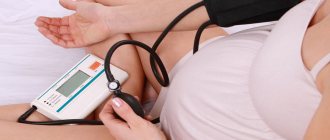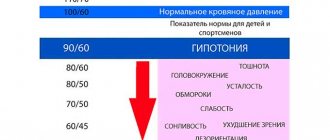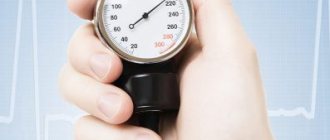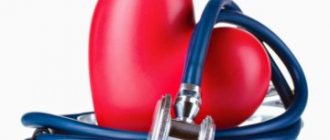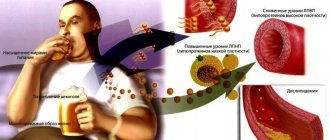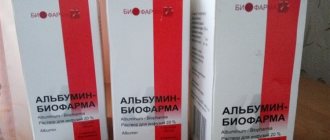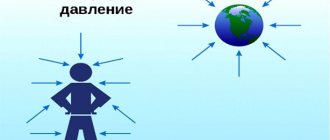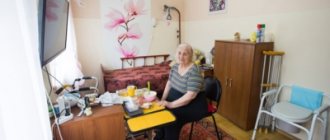The body in old age
Jumps in blood pressure in older people are associated with age-related changes in the body. Over the years, heart function deteriorates. During exercise, it poorly supplies organs and tissues with blood, which is why they lack oxygen and nutrients, endurance decreases, and a person quickly gets tired.
The elasticity of blood vessels also decreases, which is why blood pressure problems are often observed.
Elderly people are often bothered by shortness of breath, arrhythmia and other symptoms associated with deteriorating cardiovascular health. As you age, your risk of developing hypertension increases. Blood pressure can suddenly rise or fall sharply under the influence of various factors.
This is clearly observed in the example of orthostatic collapse: when a person quickly gets up after lying for a long time, the pressure decreases and the person loses consciousness.
This is especially common in people who use antihypertensive drugs, diuretics and others. Therefore, elderly people are not recommended to stand up suddenly.
Causes
There are 3 possible variants of pathological hypertension.
Primary or essential hypotension is a functional disorder of the cardiovascular system, which is one of the manifestations of neurocirculatory dystonia. Young people are susceptible to the disease; this form of hypotension is not typical for the older age group.
Secondary (symptomatic hypotension) is one of the leading symptoms of other independent diseases that cause acute and chronic decrease in blood pressure.
- myocardial infarction,
- severe heart rhythm disturbances,
- pulmonary embolism
- shock of various etiologies,
- severe intoxication,
- perforation of a gastric or duodenal ulcer,
- gastrointestinal bleeding,
- peritonitis, etc.
All of these diseases require urgent medical attention. Therefore, if a relatively healthy person’s blood pressure suddenly drops sharply, you need to urgently call an ambulance.
Chronic arterial hypotension often develops with:
- adrenal insufficiency,
- Addison's disease
- chronic pulmonary diseases,
- hypothyroidism,
- anemia.
Orthostatic arterial hypotension is a sharp decrease in pressure (systolic - by more than 20 mm Hg, diastolic - by more than 10 mm Hg) within 3 minutes after moving from a horizontal to a vertical position.
When standing up quickly, blood under the influence of gravity accumulates in the vessels of the lower extremities (this is called redistribution of blood flow), venous return to the heart decreases and pressure decreases. Normally, this decrease in pressure is quickly compensated by vasoconstriction and is short-lived. With age, the regulation of vascular tone is disrupted due to degenerative changes in the autonomic nervous system and decreased elasticity of the vascular wall. In response to a sudden rise, the veins of the legs do not have time to react and narrow, the blood stagnates (deposited) in them, and the pressure drops sharply. This kind of hypotension occurs in at least 20% of elderly people, and according to some authors, the number of such patients can reach up to 60%.
Predisposing factors to the development of orthostatic hypotension:
Neurological disorders (damage to the autonomic nervous system) with diseases such as:
- atherosclerosis of cerebral vessels,
- Parkinson's disease,
- diabetic polyneuropathy,
- B12 deficiency anemia,
- chronic alcoholism.
Hypovolemia is a decrease in the amount of fluid in the body and, as a result, the volume of circulating blood:
- intense sweating,
- severe varicose veins,
- repeated vomiting,
- profuse diarrhea,
- dumping syndrome after resection of the stomach, intestines,
- overdose of diuretics.
Severe general somatic diseases:
- IHD with rhythm disturbances,
- malnutrition, cachexia,
- mitral valve prolapse,
- hypokalemia (decreased amount of potassium in the blood),
- lung cancer.
Use of medications:
- diuretics (furosemide, torsemide),
- alpha-blockers (prosazine, doxazosin),
- ACE inhibitors (captopril, enalapril),
- antidepressants (monoamine oxidase inhibitors),
- ganglion blockers (gangleron, benzohexonium),
- tranquilizers,
- calcium antagonists (nifidepine, verapamil)
- centrally acting antihypertensive drugs (clonidine).
Orthostatic hypotension can also be provoked by prolonged lying down, hemodialysis, and psychological factors. In approximately 40% of cases the cause remains unknown.
Normal and pathological hypotension in the elderly
Blood pressure in older people fluctuates under the influence of various factors. They are divided into physiological and pathological. The first include:
- Chronic hypotension. This is low blood pressure, which is detected at a young age. In this case, the body gradually gets used to this condition, and the patient does not suffer from the unpleasant manifestations of the disease.
- Orthostatic hypotension. The problem arises if a person suddenly changes body position. This is a common problem among older people. It occurs due to the use of antihypertensive drugs for a long time or when constantly in bed due to serious illness, injury or surgery.
For normal hypotension, low diastolic or systolic pressure is observed. But in old age, this indicates the addition of cardiovascular diseases. With hypotension, both indicators decrease.
In the case of pathological hypotension, the disease will manifest itself more clearly. Factors contributing to the development of this problem in older people include:
- a decrease in the amount of circulating blood as a result of bleeding or anemia. This is the cause of half of the cases of low blood pressure;
- neurocirculatory dystonia or vegetative-vascular dystonia of the hypotonic type;
- pathologies of the endocrine system.
You can notice the problem by the presence of:
- Dizziness and nausea.
- Feelings of numbness in the limbs.
- Coldness in hands and feet.
- Depression and anxiety.
- Inexplicable fear.
- Severe headaches.
- Attacks of suffocation.
The most serious complication of this condition is a hypotensive crisis.
In this case, the person loses consciousness, the pulse will be thread-like, cold pouring sweat and blurred vision will appear. It is very difficult for older people to endure this attack, and it often leads to death.
The cause of low blood pressure in the elderly often lies in pathological processes such as heart failure, infectious diseases and others. Therefore, it is necessary to undergo an examination and determine what caused the violations.
Traditional methods of dealing with low blood pressure
There are many traditional ways to combat low blood pressure, but we must not forget that different people may react to them differently.
- Immortelle decoction
To prepare it, take a tablespoon of immortelle flowers, pour boiling water (250 ml) and keep in a water bath for 15 minutes. After this, you can strain the broth and take it. This amount of ingredients is calculated for the daily dose. The effect can be obtained if you drink the decoction three times a day - 1/3 cup before each meal.
- St. John's wort decoction
It is advisable to consult a specialist before taking St. John's wort decoction for low blood pressure. The recommended daily dose of the decoction is no more than 250 ml, and it must be adhered to. The course of treatment is no more than a month; a decoction is prepared by analogy with immortelle decoction.
- Infusion of calamus, burdock, chicory
This infusion is prepared from the roots of burdock, chicory and calamus. 100 grams of each ingredient are crushed and mixed, poured into a liter jar, which is then filled with water to the brim. The jar should be placed in a dark place for 10 days. After the specified period, take the infusion 5 drops, dissolving them in a tablespoon of water. The infusion is drunk three times a day for three weeks.
- Grape or pomegranate juice
Grape or pomegranate juice can do an excellent job of increasing blood pressure. Of course, the best effect will come from fresh; store-bought will not work, since it is canned. Buy dark grapes, squeeze the juice out of them, preferably before eating. Dosage – half a glass twice a day, course of administration – two weeks. Pomegranate juice will help cope with dizziness and headaches.
We recommend
“Boarding house for the elderly: 11 myths about the life of old people” Read more
How to raise low blood pressure
If hypotension bothers you in middle age, it is not too dangerous, but over the years the risk of complications increases. Pathology in people over 60 years of age can lead to stroke, which has been proven repeatedly.
Orthostatic hypotension is no less dangerous. It usually has the following symptoms:
- noise in the head;
- darkness in the eyes;
- dizziness;
- circulatory disorders in the brain.
Sometimes severe dizziness leads to loss of consciousness, which is also unsafe.
Therefore, you need to know how to increase blood pressure at home. The fact that the pumping function of the heart is impaired is indicated by a decrease in pulse pressure. If the lower pressure is low, then the cause of the disorder is pathologies of the cardiovascular system.
Patients living with hypotension need to know how to prevent ischemic stroke, fainting and other dangerous consequences. To do this, you should adhere to the following recommendations:
- It is imperative to monitor blood pressure readings daily. The measurement should be carried out on both hands, and the indicators should be recorded in a notebook.
- You should get out of bed very carefully. First, sit down smoothly, then sit for a while and stand up.
- If you have chronic hypotension, you should have a good breakfast. Be sure to drink a cup of coffee in the morning. The diet should contain foods containing vitamins and minerals. It is important to drink more fluid.
- It is useful to walk in the fresh air in the morning and evening.
- Physical activity should be moderate. Inactivity should be avoided.
- You should not stay in a stuffy room for a long time or be exposed to emotional and physical stress.
Thanks to these rules, you can avoid lowering your blood pressure.
If hypotension is accompanied by life-threatening symptoms, then it is necessary to urgently increase blood pressure. If the problem has been bothering you for a long time, then methods for eliminating it should be discussed with your doctor.
Most experts recommend using non-drug remedies. Basically, alcohol tinctures of medicinal plants are recommended. Tincture of Eleutherococcus or Aralia has beneficial properties. You need to take one of the medications twice a day, adding 30 drops to 60 ml of water.
Also read: Causes of high pulse with normal blood pressure An alcoholic tincture of ginseng has vasoconstrictor properties. 20 drops are placed in a spoon with water and drunk every time after meals.
Hawthorn infusion has psychostimulating properties. You can cook it yourself. To do this, the fruits should be dried and added in the amount of 1 tablespoon to 200 ml of boiled water. After this, cover and wait a few hours. Strain the finished product and drink 2 tablespoons before meals.
These methods will increase blood pressure in an elderly person if used for a long time.
Complaints
Symptoms of arterial hypotension are associated with ischemia (insufficient oxygen supply) of the brain and heart. Patients are concerned about:
- general weakness,
- dizziness,
- headache mainly in the back of the head or temples,
- heaviness in the head
- constant aching pain in the heart,
- palpitations, interruptions in heart function,
- irritability,
- tearfulness.
Deterioration can be caused by overheating, a stuffy room, stress,
In chronic diseases, hypotension is persistent; patients feel unwell throughout the day; symptoms intensify in the evening.
Acute diseases are characterized by a sudden onset with clear clinical symptoms of the underlying disease (myocardial infarction, pulmonary embolism, shock). The general condition progressively worsens, and the pressure reaches critically low values (systolic - <60 mm Hg, diastolic can drop to 0). In the absence of timely assistance, the likelihood of death is high.
Orthostatic hypertension is characterized by a transient decrease in pressure when moving from a horizontal to a vertical position. Immediately after getting out of bed or from a chair:
- sudden dizziness
- darkening in the eyes,
- noise in the head
- nausea,
- feeling of wobbly legs,
In general, the patient describes the condition as “presyncope.” Patients try to lie down again.
Orthostatic hypotension is more pronounced in the morning, in hot weather, after a heavy meal, and after physical activity.
In mild cases, all unpleasant sensations quickly pass; in more severe situations, fainting may develop.
See also:
- Antithrombotic therapy
- Kidney failure in old age
- Leg pain in older people: possible causes and treatment
During fainting, severe pale skin, cold sweat, weak pulse, and low blood pressure are noted. The patient regains consciousness after a few seconds.
Diagnosis of symptomatic hypotension is usually straightforward. In the clinical picture, the symptoms of the underlying disease come to the fore. In this case, the decrease in pressure is always secondary to the manifestations of the underlying disease.
Treatment method
Blood pressure in old age is normalized with the help of herbal preparations. Herbal medicine is considered the main method of treatment. It gives good results in combination with other methods. The duration of the course of treatment and dosage should be determined by the attending physician, depending on the condition of the whole organism and the characteristics of the course of the disease.
Elderly patients are prescribed decoctions, infusions, mixtures, teas separately and in combination with each other, as well as special medications.
Treatment
Arterial hypotension is treated not only with drugs. Depending on concomitant diseases, treatment may include folk remedies, diet, exercise therapy and other activities that have a beneficial effect on the elderly person.
Medicines
If hypotension is physiological or primary, it is enough to change your lifestyle: eliminate psycho-emotional disorders, follow a rest regime, and eat foods that increase blood pressure.
To treat chronic hypotension, such measures are not enough, so the doctor prescribes effective medications:
- "Regulon";
- "Cinnarizine";
- "Citramon";
- "Papazol";
- "Algon";
- "Piracetam";
- "Dobutamine."
Important! It is prohibited to take medications that increase blood pressure without a doctor's prescription.
Herbal remedies
As part of complex therapy, decoctions, juices and tinctures of vegetables and medicinal herbs are recommended:
- beet juice Drinking raw beet juice will help normalize blood pressure levels. To do this, it is enough to drink 100 ml of fresh juice half an hour before meals once a day;
- lemongrass tincture. This remedy promotes a rapid increase in blood pressure. Take 15 drops three times a day half an hour before meals;
- tincture of ginseng. Take the finished drug 10 drops before each meal for 14 days;
- honey and cinnamon. Consume 1 tsp before each meal. honey sprinkled with cinnamon.
Ready-made herbal tinctures and decoctions may have contraindications. Before being treated with such drugs, you need to consult a specialist.
Drug therapy
Medications used to treat low blood pressure include:
- Nootropic drugs. They help improve brain function, stimulate mental activity, improve memory, and increase the brain’s resistance to oxygen starvation, the effects of injury and toxic substances. They help people cope with psycho-emotional stress and stabilize the nervous system.
- Cerebroprotectors. They are used to prevent brain damage caused by pathogenic factors. They eliminate or reduce pathological changes in nerve cells. With the help of these drugs, they protect, improve and adapt brain structures to the negative influence of the environment.
- Vitamins B, C and E, minerals calcium, magnesium and phosphorus. With their help, they replenish the lack of nutrients in the body.
- Adrenergic agonists. These biologically active substances have a stimulating effect on adrenergic receptors, causing various metabolic or functional changes. They increase arterial pressure and decrease heart rate.
- Antidepressants and tranquilizers to restore emotional background.
With these medications you can keep your blood pressure levels within normal limits.
First aid for hypotension
Hypotension is a condition in which the brain suffers from poor blood circulation. How to quickly raise low blood pressure in an elderly person without causing harm to the body?
The following effective measures will help normalize blood circulation and improve well-being:
- strong coffee or tea. A glass of strong drink will raise blood pressure by 10–20 mmHg. Art.;
- cold and hot shower. In the absence of contraindications, such a procedure is a good way to normalize blood pressure;
- breathing exercises. Special exercises to increase blood pressure should be performed daily;
- add a salty product to your diet. Foods high in sodium contribute to high blood pressure.
If the above steps do not help restore your blood pressure to normal levels, you should consult a doctor. After carrying out diagnostic measures, the specialist will determine the cause of hypotension and prescribe the correct treatment.
Exercise therapy
Physiotherapy exercises are prescribed for:
- general strengthening of the body;
- increasing performance and emotional tone;
- normalization of nervous system functions;
- regulation of blood circulation;
- training of all organs and systems;
- increasing muscle tone;
- development of improvement of motor skills.
Therapeutic exercises are prescribed during bed rest. It allows the body to adapt to changes in body position.
A good effect in increasing blood pressure can be obtained from exercises for large muscle groups, which are performed at a slow or medium pace. They are combined with breathing and general developmental exercises.
The exercises must involve the muscles of the limbs and torso along with proper breathing. Loads can be increased as the patient's condition improves.
For physical education, they can use balls, rubber bands, exercise machines, perform exercises for balance, coordination, and improve the functions of the vestibular apparatus.
Why does blood pressure decrease?
The pressure in the body is directly related to how the heart works. There are a huge number of reasons that cause low blood pressure, and all of them must be excluded when examining the patient. Only then will the treatment be selected as correctly as possible.
Diseases that cause low blood pressure
The most common cause of low blood pressure in older people is various diseases. Accordingly, it will be necessary not only to increase the pressure, but to eliminate its cause. Low blood pressure can be observed in a person with the following deviations:
- SS pathologies. Heart rate sets the speed of blood flow through the vessels. Pathologies such as heart attack and cardiosclerosis can impair the function of the heart muscle, as a result of which blood flow slows down. In this case, a person may feel not only low blood pressure, but also symptoms such as shortness of breath, cough, severe weakness, and low pulse rate. Abnormal heart rhythm is the most common cause of hypotension.
The cause of the drop in blood pressure may be cardiac asthma
- Cardiac asthma. With this pathology, in most cases the systolic reading decreases. A person may feel worse after physical activity or stress. This is accompanied by coughing, pale skin and suffocation.
- Pulmonary edema. In this case, a decrease in pressure is observed against the background of cyanosis of the skin, the appearance of sputum with foam and enlarged veins in the neck.
- Infections. A reduced rate is quite often observed in older people when an infectious disease occurs. In this case, complaints such as increased body temperature, chills, pain, sleep disturbances and weakness appear.
- Allergic reaction. Of course, an ordinary rash or seasonal runny nose will not cause a decrease in readings, but anaphylactic shock is a common reason why blood pressure decreases. The condition is very life-threatening for the patient. The person loses consciousness, uncharacteristic skin density and a pearlescent tint appear, and breathing is impaired. If this condition is not treated in a timely manner, death can occur, and this applies not only to older people, but also to patients of any age.
Vascular dystonia can also lead to a drop in blood pressure.
- Vascular dystonia. With this pathology, especially often the pressure drops below 80/40 mmHg. Art. This is explained by dysfunction of the nervous system. The autonomic system is responsible for vascular tone and organ function.
Features of pathologies in men
In older men, blood pressure may also decrease for various reasons. Of course, age leaves its mark, but body weight is of no small importance. As already mentioned, reduced levels are more often observed in thin people. If a person feels normal, then the condition is physiological.
Most often in men, blood pressure decreases due to hereditary predisposition. It can appear regardless of a person’s age, but more often deviations begin to appear after 60 years. A lower rate is also observed among those who play sports professionally. This is a normal phenomenon and occurs due to the fact that the heart contracts stronger, but less frequently, which eliminates the risk of developing overload.
Athletes who experience high levels of exercise may also experience low blood pressure.
Important: blood flow may slow down and blood pressure may decrease if you have a large number of bad habits.
Blood pressure in women
The reason for the decrease in blood pressure in women may also be different. If at a young age women often make themselves worse by using all kinds of diets, then after 50 years some pathologies can provoke a deterioration in their well-being.
Today, fibroids are increasingly being detected among representatives of the fair sex. This pathology can also provoke a decrease in blood pressure. Another common cause of hypotension is heart failure. In this case, low diastolic pressure is accompanied by cyanosis and shortness of breath. The ECG clearly shows that the heart rate is increased, which causes an increase in the systolic rate.
Hypotension also develops in heart failure
Thus, in most cases, the presence of low blood pressure is associated with heart disease. In the elderly, there is also a decrease in the tone of the vascular walls and obvious signs of atherosclerosis. In this situation, low diastolic pressure is observed, but systole increases. As a result, peripheral vessels suffer. A common complication is ischemic disease. Before you start increasing your blood pressure, it is important to find out what is causing your condition to worsen. Only by eliminating it will it be possible to achieve stabilization of the condition in the elderly.
Lower blood pressure may be lower than normal due to Alzheimer's disease.
Diet and traditional medicine
Elderly people suffering from hypotension need to eat right. The diet should contain vitamins and minerals. You should eat more fatty meats and fish, liver, fresh and canned vegetables and fruits, berries, dairy products, and spices.
Experts recommend reducing the consumption of eggs, nuts, honey, sweets, and alcohol.
Folk remedies recommend:
- infusions of ginseng and eleutherococcus;
- St. John's wort decoction;
- valerian infusion or lemon balm tea before bed.
Elderly hypotensive patients should have herbal remedies or infusions in their home medicine cabinet.
How and with what to measure pressure
To know when and what pharmaceutical medications an elderly person should take—antihypertensive medications or drugs that increase blood pressure—you need to monitor it. You can learn how to measure parameters yourself by purchasing a proven tonometer at a pharmacy. It is advisable to choose a device that saves readings and date. Electronic and automatic devices are considered the most simple, but at the same time accurate. Learning to use them is quite easy.
Experts do not recommend purchasing mercury, external and finger tonometers for home use.
When choosing a device, you need to pay attention to the cuff; it is necessary that its bag almost completely covers the shoulder, otherwise the result can be either overestimated or underestimated.
Before you take up the tonometer, you need to learn important rules:
- Before the procedure, the bladder is emptied.
- Half an hour before it you cannot smoke, drink tea or coffee.
- When measuring pressure, you need to cross your legs and place your feet on the floor.
- The inflatable bag is placed at heart level and the cuff is wrapped around the forearm.
During the manipulation, you must sit up straight and place your hand on the table. If such requirements are ignored, the indicators are distorted. The difference can be very significant. The lower pressure rises to 11 millimeters of mercury, the upper – to 15. It is worth taking measurements both in the morning and in the evening. When using devices with built-in memory, information is saved, there is no need to keep a log of records.
Consequences
Low pressure contributes to the development of stagnant processes in the bloodstream. To compensate for this condition, the heart muscle begins to work at an increased pace and pumps out blood more intensely, which leads to the development of coronary heart disease.
In addition to ischemia, hypotension increases the risk of developing:
- stroke;
- myocardial infarction;
- Alzheimer's disease as a result of poor blood supply to the brain.
To avoid the development of these consequences, it is necessary to follow preventive measures and monitor blood pressure.
Signs of low blood pressure in older people
The first symptom of a disease such as hypotension is a rapid heartbeat. This indicates that the heart muscles cannot withstand their usual load. Of course, there are other signs. But regardless of them, urgent action must be taken. Otherwise, it can lead to serious problems, including myocardial infarction or hypotensive stroke:
- Pain in the heart and head;
- Pale and damp skin;
- The patient feels as if there is a lump stuck in his throat;
- Cold feet and hands, tremors;
- Fear of bright light;
- Loss of balance, dizziness;
- Reduced pressure to 60 mmHg.
Book a room on the website
and get 2 days
residence of a relative in a boarding house
for free
Submit your application
Prevention
In order to reduce the risk of complications and keep blood pressure levels normal, you must adhere to the following recommendations:
- do light morning exercises every morning;
- spend more time outdoors;
- go to the gym;
- take a contrast shower. It will help keep blood vessels toned.
Massage will help quickly normalize blood pressure levels. It is necessary to eat right and avoid overwork and emotional stress.
Jumps in blood pressure can be observed under the influence of bad weather conditions, stress, and various diseases. Therefore, at the first signs, it is necessary to visit a doctor and find the cause of the deviation in order to eliminate it in time. Elderly people should be especially careful about their health, as they are much more susceptible to blood pressure problems.
Symptoms
The development of hypotension is characterized by the following signs:
- weakness, fainting;
- nausea, dizziness;
- regular headaches;
- fast fatiguability;
- increased sweating;
- hearing and vision problems;
- feeling of chilliness in the limbs.
In addition, older people with low blood pressure often experience depression and apathy.
Why is this condition dangerous?
Some people often experience low blood pressure and high pulse. What to do with this pathology? Most patients do not even attach due importance to this condition. This approach is completely wrong.
A heart that functions rhythmically will last a long time. Thus, the duration of human life depends entirely on how calmly this important organ works. After all, only with its normal functioning is the economical flow of all important processes ensured.
If the heart begins to contract in an increased mode, then the supply of blood to all organs is disrupted. As a result, oxygen starvation occurs. This condition most strongly affects the brain. This is why fainting occurs as a result of heart failure.
In addition, irregular functioning leads to various chronic pathologies. The strongest pulsation in acute form can provoke lightning death in a heart attack.
Reasons for the downgrade
Hypotension rarely occurs as an independent disease. Its development occurs as a consequence of another disorder. There are various factors that contribute to the fact that blood pressure begins to drop.
Physiological
For older people, hypotension is dangerous; an attack can result in a stroke. Low blood pressure levels are sometimes detected in childhood, and they are constantly present. The patient gradually adapts to his condition and feels normal with chronic hypotension.
Pressure drops:
- after prolonged use of antihypertensive drugs;
- due to blood loss during surgery or injury;
- long stay in bed.
Such physiological causes lead to the development of orthostatic type of hypotension, when low pressure provokes difficulty in the flow of blood to the brain, and this sometimes ends in fainting.
Pathological causes
In case of disturbances in the endocrine system, damage to various organs, due to the presence of anemia, which occurs when the volume of blood circulating through the vessels decreases, pathological hypotension develops. Helps reduce blood pressure:
- mental disorders;
- heart diseases;
- brain injuries.
In old age, the body is depleted by intense physical activity, fasting, a poor diet, the presence of tumors, lung pathologies, osteochondrosis, allergies, and vegetative-vascular dystonia. This leads to the fact that the pressure drops, and if it is low, the tissues do not receive normal nutrition and experience a lack of oxygen. A person feels constant weakness, drowsiness, and loses ability to work.
In old age, the normal difference between upper and lower pressure is disrupted. As this indicator increases, the heart loses its ability to pass blood, and the valves lose their tightness. When it decreases, the vessels sharply tense, and a spasm occurs.
First aid at home
If low blood pressure and high pulse suddenly occur, what should be done in this case and what should be proper first aid in this condition?
If a person has a sharp decrease in blood pressure, tinnitus and dizziness, then the following must be done:
- Give the patient a horizontal position, or even better, use a stand or bolster for the legs so that they are higher than the head.
- If a person is shaking with chills, he should be wrapped in a blanket.
- At the same time, you need to free him from the pressing parts in his clothes so that breathing does not become difficult.
- Provide a flow of fresh air into the room.
- When sitting, it is recommended to lower your head below your knees.
- If a person loses consciousness before the doctor arrives, they should pat him on the cheeks and sprinkle cool water on his face.
When low blood pressure and high pulse appear, what to do at home? There are several effective methods for restoring normal heart rhythm, and this first aid can be significant:
- apply slight pressure with your thumbs for some time on closed eyelids;
- take a deep breath, hold your breath for 15 seconds, and then, holding it with your fingers, try to forcefully exhale the air (this will help influence the vagus nerve and slow down the heart rate);
- Tighten your abdominal muscles as much as possible (for 15 seconds), do this several times.
First aid
So, if a patient has low blood pressure and a high pulse, what should you do? In case of an acute attack, you need to resort to the following measures:
- Initially, give the patient a tincture of motherwort or valerian. A good result will be provided by the drugs “Valocordin” and “Validol”.
- Show the patient how he needs to breathe. In this situation, it is recommended to take a deep breath and then hold your breath. It is necessary not to exhale for as long as possible. Such simple gymnastics will quickly normalize the patient’s condition.
- Ask the person to tense their abdominal muscles tightly. This procedure also promotes recovery.
- Rosehip decoction is very useful for this phenomenon. Honey and black currant will bring benefits.
Now you know what to do if you have low blood pressure and high pulse. First aid will greatly alleviate the patient's condition. However, do not forget that such activities are not treatment. They can only help for a while.
Therefore, if you often encounter an unpleasant condition, be sure to visit a doctor. As a rule, you will be examined not only by a general practitioner, but also by a cardiologist and an endocrinologist. And if necessary, they will refer you to other specialists.
Everyone knows that for hypotensive people, low blood pressure is the norm. But what to do if low blood pressure and high pulse make you feel worse? Why does the heart begin to contract faster and the pulse quicken? This condition may indicate the development of serious pathologies associated with damage to the cardiovascular system. Therefore, if alarming symptoms appear, you should rush to see a cardiologist.
What could be the consequences?
Interestingly, quite a large number of people live with low blood pressure for a long time and do not even notice it. They have the advantage of no restrictions on food and drinks such as coffee, chocolate, and strong tea.
But it is worth understanding that a sharp one-time drop in pressure to a critical level of 60 to 40 may indicate serious violations. For example, this is possible with open gastrointestinal bleeding, as well as problems with the adrenal glands and endocrine disease.
Cardiogenic shock has 4 types, each of which complicates the functioning of the entire body and can ultimately lead to death. Arrhythmic shock can result from tachycardia of the cardiac ventricles. True cardiogenic shock occurs when the heart's ability to pump is reduced. Reflex occurs due to sharp pain. Areactive does not respond to active resuscitation efforts.
Cardiogenic shock can develop due to myocardial infarction, when more than 40% of the heart muscle is affected, or due to diabetes mellitus.
Why does older men and women experience low blood pressure?
- Men
Elderly men are in a hypotensive state for a number of reasons. Most often, the numbers do not reach normal values in people of thin build. In the absence of adverse symptoms, hypotension is perceived as a physiological feature.
Hereditary predisposition and professional sports training are factors that can manifest themselves in old age in the form of low blood pressure. Most often, manifestations are noticed over the age of sixty years. The condition is not considered a pathology and is not corrected unless absolutely necessary.
- Women
Various reasons contribute to a decrease in blood pressure in women. In their youth, girls torture themselves with all sorts of diets, which has a negative impact on their health, including blood pressure. If a woman is over fifty years old, low blood pressure may indicate some pathology.
The most common cause of hypotension is weakness of the heart muscle. This condition is often accompanied by weakness, nausea, frequent severe headaches, dizziness, increased sweating, pale skin and other symptoms. In such cases, self-medication is contraindicated; the help of a doctor is necessary.
We recommend
“Care for elderly people over 80 years old” Read more
Causes
There are several reasons why this condition may occur:
- Heredity.
- Sedentary work and sedentary lifestyle.
- Work in hazardous production.
- Pregnancy, especially with toxicosis.
- Elderly age.
Hypotension is also common in adolescents. If it does not cause you to feel unwell and does not interfere, then you can completely ignore this condition. This does not apply to elderly patients, as well as those who suffer from low blood pressure. Therefore, it is worth knowing what to do if the pressure is 60 to 40.
Medication methods
If necessary, if it is impossible to cope with a sharp deterioration of the condition without medications, it is possible to take one of the medications that help increase blood pressure. Many doctors consider the following to be the most effective:
- citramon,
- papazole,
- camphor,
- aspirin,
- metazon and some others.
However, the constant use of these drugs, especially without any medical advice, is prohibited, as they can contribute to the development of quite serious side effects.
What to do?
What should you do if low blood pressure and high pulse are accompanied by a significant deterioration in your condition and occur against the background of other symptoms of trouble?
Many drugs that slow the heart rate have the ability to lower blood pressure. Therefore, with concomitant hypotension, treatment presents certain difficulties.
Is it possible to take beta-blockers (Anaprilin, Concor, etc.)?
To effectively restore the normal frequency of myocardial contractions, beta-blockers are often used. For example, Anaprilin is the drug of choice for low blood pressure and tachycardia, especially if such conditions occur in the form of attacks.
This often happens with VSD. This remedy requires a careful approach and constant monitoring of blood pressure.
New generation drugs provide assistance more selectively. The selective agent Bisoprolol, or Concor, is also successfully used for low blood pressure and tachycardia. It does not reduce blood pressure as dramatically, but you should also be careful when using it and measure constantly. It is best used in the presence of cardiac ischemia, since Concor has an antianginal effect and, with constant use, can reduce the frequency of painful attacks.
Sedatives (Valoserdin, Corvalol, etc.)
If significant hypotension and tachycardia are observed, what to take in this case, you should ask a specialist. In many cases, the cause is stress and overwork, so sedatives help normalize the condition.
Validol or Valoserdin are successfully used for low blood pressure and tachycardia. They help restore the body after stress and normalize sleep.
conclusions
Low blood pressure is rare in people over 50 years of age. The main cause of the phenomenon is considered to be genetic predisposition. This condition (sometimes caused by coronary artery disease, or impaired renal function) can be accompanied by a sharp disruption of cerebral blood supply, and therefore requires close attention.
Treatment of hypotension in older people includes the use of medications such as caffeine and herbal tonics. Physiotherapeutic measures are also recommended for the patient.
The following sources of information were used to prepare the material.
Low blood pressure causes no less health problems than high blood pressure. Therefore, all patients with problematic vessels should know how to react to a pressure of 60 to 40. And for a healthy person who has suddenly experienced a downward spiral, such information will not hurt.


